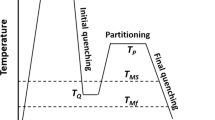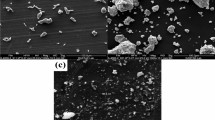Abstract
The present study aimed to investigate the dependence of fatigue properties of A356 casting alloy on the variation of stress ratio (R-value) in terms of the mutual contribution of strain components and porosity to fatigue life. The fatigue test was carried out in axial high-cycle fatigue mode through the variation of R-value by the addition of compressive load to a fixed tensile stress amplitude (R = 0.0, − 0.5, − 1.0) and by the variation of tensile and compressive loads in a fixed total stress range (R = − 0.58 ~ − 1.25), respectively. The decrease in R-value by the addition of a compressive load at a fixed tensile stress amplitude wholly reduces the slope of the S-N curve (fatigue strength exponent), because the nominal level of fatigue life becomes increasingly sensitive with the porosity variation as R-value decreases; fundamentally, the increase in total stress range induces a remarkable increase in the plastic strain as well as the elastic strain. Meanwhile, the decrease of R-value by the variation of tensile/compressive load to a fixed total stress range induces a different aspect on the dependence of fatigue life on the porosity variation: the nominal value of defect susceptibility coefficient remarkably increases with a wide range and the decrease of maximum fatigue life is restricted to a small range, by a relatively small variation of both strain components. However, as the R-value decreases in both loading conditions, the propagation path of a fatigue crack gradually transitions from a cracking mode, in which the cracking damage of eutectic Si particles dominates, to a mixed mode of matrix penetration by local plastic deformation and cracking damage of eutectic Si particles, which mainly accumulate by compressive loading conditions.














Similar content being viewed by others
References
G.E. Dieter, Mechanical Metallurgy, 3rd ed., McGraw-Hill, New York, (1986) Chap. 12, p. 392.
A.M. Gokhale and G.R. Patel, Quantitative Fractographic Analysis of Variability in Tensile Ductility of a Squeeze Cast Al-Si-Mg Base Alloy, Mater. Charac., 2005, 54, p 13–20.
A.M. Gokhale and G.R. Patel, Analysis of Variability in Tensile Ductility of a Semi-solid Metal Cast A356 Al-Alloy, Mater. Sci. Eng. A, 2005, 392, p 184–190.
C.D. Lee, Variability in the Tensile Properties of Squeeze-Cast Al–Si–Cu–Mg alloy, Mater. Sci. Eng. A, 2008, 488, p 296–302.
C.D. Lee and K.S. Shin, Constitutive Prediction of the Defect Susceptibility of Tensile Properties to Microporosity Variation in A356 Aluminum Alloy, Mater. Sci. Eng. A, 2014, 599, p 223–232.
SAE J1099, Technical Report on Low Cycle Fatigue Properties Ferrous and Non-ferrous Materials, 1998.
ASTM E466, Standard Practice for Conducting Force Controlled Constant Amplitude Axial Fatigue Tests of Metallic Material, 2002
C.D. Lee, Effect of T6 Heat Treatment on the Defect Susceptibility of Fatigue Properties to Microporosity Variation in a Low-Pressure Die-Cast A356 Alloy, Mater. Sci. Eng. A, 2013, 559, p 496–505.
Q.G. Wang, D. Apelian and D.A. Lados, Fatigue Behaviour of A356–T6 Aluminum Cast Alloys. Part I-Effect of Casting Defects, J. Light Met., 2001, 1, p 73–84.
H. Xue, Z. Sun, X. Zhang, T. Gao and Z. Li, Very High Cycle Fatigue of a Cast Aluminium Alloy: Size Effect and Crack Initiation, J. Mater. Eng. Perform., 2018, 27, p 5406–5416.
M.Z. Wu, J.W. Zhang, Y.B. Zhang and H.Q. Wang, Effects of Mg Content on the Fatigue Strength and Fracture Behaviour of Al-Si-Mg Casting Alloys, J. Mater. Eng. Perform., 2017, 27, p 5992–6003.
P. Szalva and I.M. Orbulov, Influence of Vacuum Support on the Fatigue Life of AlSi9Cu3(Fe) aluminium Alloy Die Casting, J. Mater. Eng. Perform., 2020, 29, p 5685–5695.
C.D. Lee, Effect of Microporosity and loading Condition on Fatigue Life of A356 Casting Alloys, Mater. Sci. Eng. A, 2020, 776, p 138992. https://doi.org/10.1016/j.msea.2020.138992
C.D. Lee, Effect of Strain Rate on Fatigue Property of A356 Aluminium Casting Alloys Containing Pre-existing Micro-voids, Int. J. Fatigue, 2020, 131, p 105368. https://doi.org/10.1016/j.ijfatigue.2019.105368
D.F. Mo, G.Q. He, Z.F. Hu, X.S. Liu and W.H. Zhang, Effect of Microstructural Features on Fatigue Behaviour in A319–T6 Aluminum Alloy, Mater. Sci. Eng. A, 2010, 527, p 3420–3426.
H.A. Elhadari, H.A. Patel, D.L. Chen and W. Kasprazak, Tensile and Fatigue Properties of a Cast Aluminium Alloy with Ti, Zr and V Additions, Mater. Sci. Eng. A, 2011, 528, p 8128–8138.
B.A. Rutherford, A.R. Cisko, P.G. Allison and J.B. Jordon, Effect of Tensile Mean Strain on Fatigue Behaviour of Al-Li Alloy, J. Mater. Eng. Perform., 2020, 29, p 4928–4933.
R. Maity, A. Singh and S.K. Paul, Investigations of Fatigue and Fracture Behaviour of AA7085, J. Mater. Eng. Perform., 2021 https://doi.org/10.1007/s11665-021-05914-x
H. Özdes and M. Tiryakioğlu, The Effect of Structural Quality on Fatigue Life in 319 Aluminum Alloy Castings, J. Mater. Eng. Perform., 2017, 26, p 736–743.
J.G. Kaufman and E.L. Rooy, Aluminum Alloy Casting; Properties, Processes, and Applications, ASM inter., 2004, Chap. 8, p. 69.
J.G. Kaufman, Properties of Aluminum Alloys; Fatigue Data and the Effects of Temperature, Product Form, and Processing, ASM inter., 2008, Chap. 6, p. 441.
C.D. Lee, J.I. Youn and Y.J. Kim, Effect of Strain Rate on the Defect Susceptibility of Tensile Properties to Porosity Variation, Mater. Sci. Eng. A, 2017, 683, p 135–142.
C.H. Cáceres, J.R. Griffiths and P. Reiner, The Influence of Microstructure on the Bauschinger Effect in an Al-Si-Mg Casting Alloy, Acta Mater., 1996, 44, p 15–23.
M.F. Horstemeyer, Damage Influence on Bauschinger Effect of a Cast A356 Aluminum Alloy, Scr Mater., 1998, 39, p 1491–1495.
M.D. Dighe, A.M. Gokhale and M.F. Horstemeyer, Effect of Loading Condition and Stress State on Damage Evolution of Silicon Particles in an Al-Si-Mg-Base Cast Alloy, Met. Mater. Trans., 2002, 33A, p 555–565.
Acknowledgment
This research was supported by the General Researcher Program through the National Research Foundation of Korea (NRF) and funded by the Ministry of Education, Science, and Technology (NRF-2017R1D1A1B03028953/NRF-2020R1F1A1068118).
Author information
Authors and Affiliations
Corresponding author
Additional information
Publisher's Note
Springer Nature remains neutral with regard to jurisdictional claims in published maps and institutional affiliations.
Rights and permissions
About this article
Cite this article
Lee, C. Effect of Stress Ratio on Fatigue Life of A356 Aluminium Casting Alloys. J. of Materi Eng and Perform 31, 1066–1076 (2022). https://doi.org/10.1007/s11665-021-06297-9
Received:
Revised:
Accepted:
Published:
Issue Date:
DOI: https://doi.org/10.1007/s11665-021-06297-9




